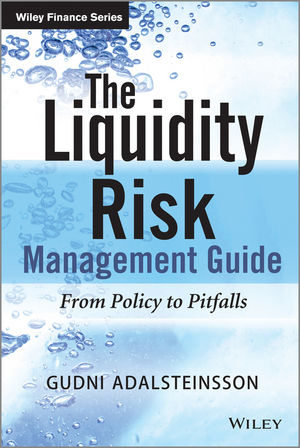
The Liquidity Risk Management Guide
John Wiley & Sons Inc (Verlag)
978-1-118-85800-4 (ISBN)
Liquidity risk is in the spotlight of both regulators and management teams across the banking industry. The European banking regulator has introduced and implemented a stronger liquidity regulatory framework and local regulators have made liquidity a top priority on their supervisory agenda. Banks have accordingly followed suit. Liquidity risk is now a topic widely discussed in boardrooms as banks strive to set up a strong and efficient liquidity risk management framework which, while maintaining sufficient resources, does not jeopardize the necessary profitability and return targets.
The Liquidity Risk Management Guide: From Policy to Pitfalls is practical guide for banks and risk professionals to proactively manage liquidity risk in a systemic way. The book sets out its own comprehensive framework, which includes all the various and critical components of liquidity risk management. The recommendations are based on experiences from the recent financial crises, best practices and compliance with current and future regulatory requirements, with special emphasis on Basel III.
Using the new 6 Step Framework, the book provides step-by-step guidance for the reader to build their liquidity management framework into a new overarching structure, which brings all the different parts of liquidity risk into one approach. Special attention is given to the challenges that banks currently face when adopting and implementing the Basel III liquidity requirements and guidance is given on how the new metrics can be integrated into the existing framework, providing the most value to the banks instead of being a regulatory reporting matter.
GUDNI ADALSTEINSSON is the manager for Asset Liability and Management at one of the Irish banks in the UK, responsible for overall balance sheet management. His experience ranges from running the group treasury for a European bank during the credit crunch, working for the Financial Services Authority, to providing liquidity advice to UK banks. Adalsteinsson was a group treasurer for an Icelandic bank during the unprecedented liquidity shocks of 2008, which offered him first-hand experience of liquidity risk management under severe crisis. Between the years of 1998 and 2005, he was an executive director at Lehman Brothers and Credit Suisse in London and Frankfurt, advising German banks on their liquidity and structured credit investments. He has been a board member of banks in the UK and Denmark. Adalsteinsson holds an MBA degree from the University of Cambridge and a bachelor’s degree in economics from the University of Iceland.
Preface xi
List of Figures xiii
1 Introduction 1
1.1 The importance of an overarching liquidity risk management framework 3
1.2 The ‘6 Step Framework’ 4
1.3 The structure of the book 5
2 Primer in Banking 7
2.1 Risk in banking 7
2.1.1 Managing the risk 9
2.1.2 The bank’s balance sheet 11
3 The ALM Function – The Framework on Top of Liquidity Management 13
3.1 ALM within risk, finance and the businesses 14
3.1.1 Centralization versus decentralization 14
3.1.2 Accounting and ALM 15
3.2 The Asset–Liability Committee (ALCO) 16
3.3 Areas covered by ALCO 17
3.3.1 Interest rate risk management 18
3.3.2 Liquidity risk management 18
3.3.3 Capital reporting and management 19
3.3.4 Setting or recommending risk limits 19
3.4 Enhanced role of the ALM unit 20
4 Liquidity – Background and Key Concepts 23
4.1 Definitions and more definitions 23
4.1.1 Liquidity – definition 23
4.1.2 Liquidity risk 25
4.2 The liquidity gap 26
4.3 The timing factor of liquidity risk: tactical, structural and contingent 27
4.4 It’s all about the ‘L’ word 30
4.5 Liquidity, solvency and capital 30
4.6 Liquidity from a macroeconomic perspective – the singular case of contagion risk and asymmetric information 31
5 The Appropriate Liquidity Framework – Introduction to the ‘6 Step Framework’ 35
5.1 Setting the stage – from policy to a practical framework 35
5.2 The heightened regulatory focus on liquidity 36
5.3 Recommended liquidity risk management framework – The ‘6 Step Framework’ 38
6 Step I: Sources of Liquidity Risk 43
6.1 The 10 Sources of Liquidity Risk 45
6.1.1 Definition of retail and wholesale liabilities 45
6.1.2 Wholesale funding risk 46
6.1.3 Retail funding risk 50
6.1.4 Intraday liquidity risk 57
6.1.5 Intragroup liquidity risk 60
6.1.6 Off-balance sheet liquidity risk 61
6.1.7 Cross-currency liquidity risk 63
6.1.8 Funding cost risk 63
6.1.9 Asset risk 64
6.1.10 Funding concentration risk 65
6.1.11 Correlation and contagion risk 66
7 Step II: Risk Appetite 69
7.1 The risk appetite statement 69
7.1.1 Eggs, omelettes and a free lunch in the Board room 69
7.2 Drawing up a risk appetite statement 70
7.2.1 Risk appetite set at the appropriate level 71
7.2.2 Liquidity risk statement – tolerance limit approach 73
7.2.3 Liquidity risk statement – survival time period or scenario-based approach 75
7.3 The liquidity reserve 76
7.3.1 A liquidity reserve or a liquidity buffer? 78
7.3.2 How to review the risk appetite? 78
8 Step III: Governance and High-Level Policy 81
8.1 The role of the Board of directors 82
8.2 The role of senior management 83
8.2.1 First down then up again 84
8.3 High-level liquidity policies and strategies 84
8.4 Liquidity policy 85
8.5 Funding strategy 88
8.5.1 Examination of the business strategy/plan requirements 88
8.5.2 Assessment of funding sources and their attractiveness 90
8.5.3 Medium- and longer-term funding plans 91
8.6 Funds transfer pricing 95
8.6.1 Funds transfer pricing in a nutshell 96
8.6.2 The FTP principles and objectives 97
8.6.3 Construction of an FTP model 98
8.6.4 The FTP method in two steps 99
8.6.5 The pooled (average) cost method 103
8.6.6 The matched funding method 104
8.6.7 Funds transfer pricing in application 105
9 Step IV: The Quantitative Framework 111
9.1 Different ways to measure liquidity 111
9.1.1 Balance sheet analysis 112
9.1.2 Cash flow analysis 115
10 Step V: Stress Testing and the Contingency Funding Plan 123
10.1 Stress testing – the heart of the liquidity framework 123
10.1.1 How banks perform their stress tests 124
10.1.2 Where stress tests failed during the financial crises 124
10.1.3 The principles of stress testing 125
10.1.4 Stress testing within the ‘6 Step Framework’ 126
10.1.5 Picking the model 126
10.1.6 The limitation of VaR for liquidity risk stress testing 127
10.1.7 The deterministic ‘what if’ approach 127
10.1.8 Setting of the deterministic scenario 128
10.1.9 Choice of severity 129
10.1.10 Choice of time horizon 132
10.1.11 Scenario stress testing, step by step 133
10.1.12 Define the scenarios 134
10.1.13 Playing out the scenario 135
10.1.14 Analysing the outcome 141
10.2 Final note on scenario stress testing 144
10.2.1 Reverse stress testing 146
10.3 Contingency funding plan (CFP) – the SPADE of the liquidity framework 146
10.3.1 The regulatory requirement 148
10.3.2 Why banks need a CFP 148
10.3.3 The CFP process 149
10.3.4 Spotting the risk – triggers and early warning indicators 150
10.3.5 Assessing the risk and alert level – the boy who cried wolf 153
10.3.6 Decisions and action plans 155
10.3.7 Execution 160
11 Step VI: Reporting and Management Information 169
11.1 Internal controls and internal audit processes 171
12 Basel III: The New Global Framework 173
12.1 Basel III – beyond the buzzwords 173
12.1.1 The Basel Committee on Banking Supervision (BCBS) 173
12.1.2 Short Summary of the Regulatory Framework Leading Up to Basel III 173
12.1.3 Basel III 174
12.1.4 Capital Requirements Directive (CRD) and the single rulebook 176
12.2 The Basel III liquidity ratios 177
12.3 The liquidity coverage ratio (LCR) 178
12.3.1 Challenges the LCR Will Bring to the liquidity framework 180
12.3.2 The Basel III definitions and stress assumptions 181
12.3.3 LCR common disclosure template 183
12.4 The net stable funding ratio (NSFR) 185
Bibliography 187
Index 193
| Erscheint lt. Verlag | 21.7.2014 |
|---|---|
| Reihe/Serie | Wiley Finance Series ; 1 |
| Verlagsort | New York |
| Sprache | englisch |
| Maße | 178 x 246 mm |
| Gewicht | 567 g |
| Themenwelt | Wirtschaft ► Betriebswirtschaft / Management ► Finanzierung |
| ISBN-10 | 1-118-85800-X / 111885800X |
| ISBN-13 | 978-1-118-85800-4 / 9781118858004 |
| Zustand | Neuware |
| Haben Sie eine Frage zum Produkt? |
aus dem Bereich


